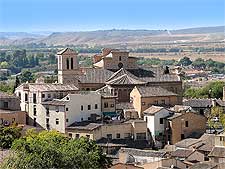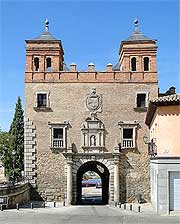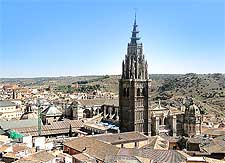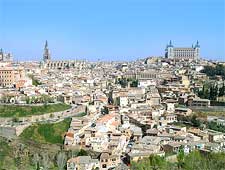Toledo History Facts and Timeline
(Toledo, Castile-La Mancha, Spain)

With a history stretching back to the Bronze Age, Toledo is one of Spain's most diverse and engaging cities. It has a deserved reputation as a centre of culture, learning and ethnicity.
At its peak in the 11th century, the city was a haven of tolerance where Christians, Jews and Muslims all coexisted and shared their knowledge. This rich ethnic integration shaped the history of Toledo into the rich mosaic of Moorish, Jewish and Spanish heritage enjoyed today.
Roman Era
The earliest recorded history of Toledo comes from the Romans, who captured this Iberian city in the year of 192 BC. Its geographic location in the heart of Spain ensured its importance to future generations of conquerors. Situated on a hill and protected by a deep river on no less than three sides, Toledo was an ideal defensive spot. The Romans soon established an impressive infrastructure, building aqueducts, stone bridges and grand public buildings like the rather ambitious Roman circus. However, nearly all traces of this prosperous Roman era have long been buried.

Visigothic Times
When the Roman Empire fell, the Visigoths moved in and established control of the Iberian Peninsula. They made Toledo their capital from 570 AD until the Moors conquered them in 711 AD.
Their rule may have been relatively short, but the Visigoths left behind administrative elements like various rules and enforced laws, as well as a centralised government and a taxation system that formed the foundations of modern Spain.
The only remains of their presence can be seen in the Santa Cruz Museum, on the Calle de Miguel de Cervantes.
The Moors
When the Moors conquered Iberia in the early 8th century, Toledo was rather distant from their centre in Cordoba, to the far south. The wealthy educated Christians of Toledo were reduced to a minority, but they constantly rebelled against Moorish rule, trying to break away. This dark era of conflict saw many terrible events such as the Day of the Pit in 807 AD, when more than 5,000 Toldedans were invited to a party in the Alcazar (a fortified Moorish palace) and then barbarically executed upon their arrival, with their bodies being thrown into a giant pit.
Even this brutal act didn't deter the rebellion, and in 932 AD the Moorish governor was forced to concede a certain level of autonomy to the Christians of Toledo. During this relatively peaceful era, the Alcazar palace and city walls were restored and the Alcantara Bridge built. As the rule in Cordoba began to fall apart, Moorish intellectuals soon fled here.

The Golden Era
King Alfonso VI of Castile took advantage of the infighting between the Moors to take Toledo in 1085, ushering in the Christian era that would continue through today. This opened the doors on the golden era of Toledo history, when the city became something of a haven for ethnic tolerance between the Arabs, the Jews and also the Christians.
Arab workers and craftsmen built many of the city's great structures, while Jews held positions of power. It wasn't long before the city was flourishing in the arts, culture, science and intellectual debate. Toledo became the seat of the Catholic Church, ensuring its importance and influence for many decades to come.

The Conversos
Things took a dark turn when
Granada fell to the Spaniards in the year of 1492. This marked the end of cultural tolerance, as Jews and Muslims in Toledo were forced to either convert to Catholicism or flee the city.
Most of them fled during the period referred to as the Conversos.
The city was to become the new capital of Spain under Carlos I. His successor Felipe II later chose
Madrid as the capital, where it remains today.
A Forgotten City
As the city's power and influence faded into obscurity over the next two centuries, the city was very much left to its own devices. Fortunately, the magnificent architecture was not destroyed even when the Alcazar emerged as a symbol of fascist resistance during the Spanish Civil War.
Artists such as El Greco rediscovered Toledo's beauty and helped it to rightfully return to the cultural map. In the mid-1980s, UNESCO decreed that the entire city had gained the title of World Heritage Site due to its wealth of preserved sites representing the diverse heritage that Toledo has experienced throughout its long history.
 With a history stretching back to the Bronze Age, Toledo is one of Spain's most diverse and engaging cities. It has a deserved reputation as a centre of culture, learning and ethnicity.
With a history stretching back to the Bronze Age, Toledo is one of Spain's most diverse and engaging cities. It has a deserved reputation as a centre of culture, learning and ethnicity.

